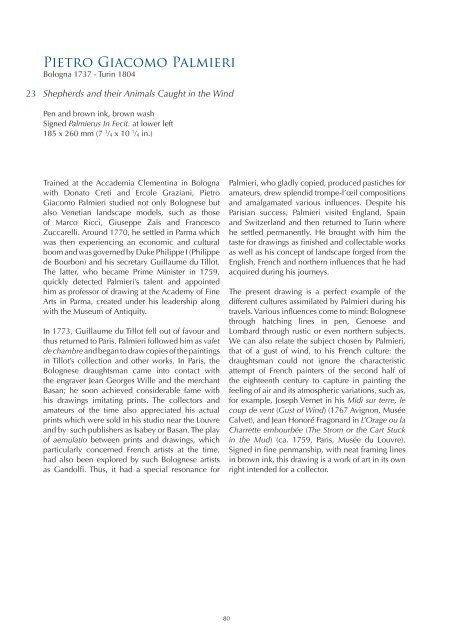Works on Paper 2019 - Jean Luc Baroni
- No tags were found...
Create successful ePaper yourself
Turn your PDF publications into a flip-book with our unique Google optimized e-Paper software.
Pietro Giacomo Palmieri<br />
Bologna 1737 - Turin 1804<br />
23<br />
Shepherds and their Animals Caught in the Wind<br />
Pen and brown ink, brown wash<br />
Signed Palmierus In Fecit. at lower left<br />
185 x 260 mm (7 1 /4 x 10 1 /4 in.)<br />
Trained at the Accademia Clementina in Bologna<br />
with D<strong>on</strong>ato Creti and Ercole Graziani, Pietro<br />
Giacomo Palmieri studied not <strong>on</strong>ly Bolognese but<br />
also Venetian landscape models, such as those<br />
of Marco Ricci, Giuseppe Zaïs and Francesco<br />
Zuccarelli. Around 1770, he settled in Parma which<br />
was then experiencing an ec<strong>on</strong>omic and cultural<br />
boom and was governed by Duke Philippe I (Philippe<br />
de Bourb<strong>on</strong>) and his secretary Guillaume du Tillot.<br />
The latter, who became Prime Minister in 1759,<br />
quickly detected Palmieri’s talent and appointed<br />
him as professor of drawing at the Academy of Fine<br />
Arts in Parma, created under his leadership al<strong>on</strong>g<br />
with the Museum of Antiquity.<br />
In 1773, Guillaume du Tillot fell out of favour and<br />
thus returned to Paris. Palmieri followed him as valet<br />
de chambre and began to draw copies of the paintings<br />
in Tillot’s collecti<strong>on</strong> and other works. In Paris, the<br />
Bolognese draughtsman came into c<strong>on</strong>tact with<br />
the engraver <strong>Jean</strong> Georges Wille and the merchant<br />
Basan; he so<strong>on</strong> achieved c<strong>on</strong>siderable fame with<br />
his drawings imitating prints. The collectors and<br />
amateurs of the time also appreciated his actual<br />
prints which were sold in his studio near the Louvre<br />
and by such publishers as Isabey or Basan. The play<br />
of aemulatio between prints and drawings, which<br />
particularly c<strong>on</strong>cerned French artists at the time,<br />
had also been explored by such Bolognese artists<br />
as Gandolfi. Thus, it had a special res<strong>on</strong>ance for<br />
Palmieri, who gladly copied, produced pastiches for<br />
amateurs, drew splendid trompe-l’œil compositi<strong>on</strong>s<br />
and amalgamated various influences. Despite his<br />
Parisian success, Palmieri visited England, Spain<br />
and Switzerland and then returned to Turin where<br />
he settled permanently. He brought with him the<br />
taste for drawings as finished and collectable works<br />
as well as his c<strong>on</strong>cept of landscape forged from the<br />
English, French and northern influences that he had<br />
acquired during his journeys.<br />
The present drawing is a perfect example of the<br />
different cultures assimilated by Palmieri during his<br />
travels. Various influences come to mind: Bolognese<br />
through hatching lines in pen, Genoese and<br />
Lombard through rustic or even northern subjects.<br />
We can also relate the subject chosen by Palmieri,<br />
that of a gust of wind, to his French culture: the<br />
draughtsman could not ignore the characteristic<br />
attempt of French painters of the sec<strong>on</strong>d half of<br />
the eighteenth century to capture in painting the<br />
feeling of air and its atmospheric variati<strong>on</strong>s, such as,<br />
for example, Joseph Vernet in his Midi sur terre, le<br />
coup de vent (Gust of Wind) (1767 Avign<strong>on</strong>, Musée<br />
Calvet), and <strong>Jean</strong> H<strong>on</strong>oré Frag<strong>on</strong>ard in L’Orage ou la<br />
Charrette embourbée (The Strom or the Cart Stuck<br />
in the Mud) (ca. 1759, Paris, Musée du Louvre).<br />
Signed in fine penmanship, with neat framing lines<br />
in brown ink, this drawing is a work of art in its own<br />
right intended for a collector.<br />
80
















